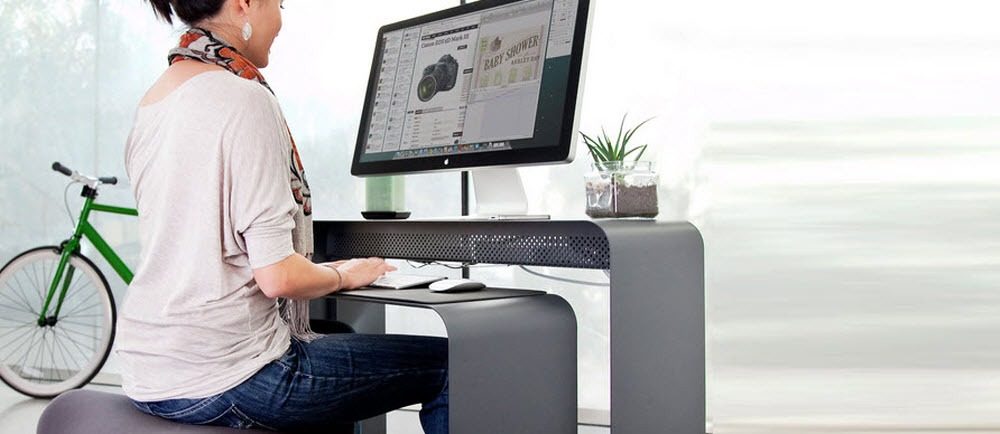
Prolonged use of a computer can lead to frequent muscle aches and nerve pain unless a few guidelines are followed. You can work more comfortably and safely if you incorporate the ergonomics for computer users.
Check ergonomics tips for computer users in this article of FittingChairs.
What is computer ergonomics?
Ergonomics is the science of designing a job, equipment and workplace to fit the worker. The goal is to optimize the fit between each worker and his or her work environment, as well as to optimize performance and reduce the risk of repetitive strain injuries.
Computer ergonomics addresses ways to optimize your computer workstation to reduce the specific risks of computer vision syndrome, neck and back pain, carpal tunnel syndrome and other disorders affecting the muscles, spine and joints.
When talking about designing a computer workstation with the goal of preventing Computer Vision Syndrome, some experts in this field also use the term “visual ergonomics”.

What are the health risks of working at a computer frequently?
Working at a computer for prolonged periods can be harmful to your eyes, neck, and backache. It some cases, it can even lead to poor digestion, headaches, repetitive stress injury and vision problems.
Computer vision syndrome
Computer vision syndrome refers to a group of eye and vision-related problems that result from prolonged computer use. Symptoms of computer vision syndrome include:
Dry eyes
Computers can cause dry eyes, as they can affect the way we blink. If you are blinking less, tears in your eyes have more time to evaporate, resulting in red and dry eyes. This can even cause blurred vision in some cases.
Eyestrain
Eyestrain can occur when we force our eyes to focus on an unhealthy, unnatural position. The awkward postures strain the eye muscles and can cause pain and aching.
Blurred vision
Blurred vision is commonly caused by looking at a screen that is too bright or sitting too close to a monitor. It’s also caused by looking at a screen for long without any breaks.
Headache
Headaches are a common complaint from people who spend prolonged periods sat at a computer. Headaches can also be caused by eye strain.
Neck and back pain

Straining your muscles to look at a computer is a common cause of back and neck ache, as your body forced into an unnatural position.
Carpal tunnel syndrome
Carpal tunnel is a condition that causes pain, numbness, and tingling in the hand and arm. This is commonly caused by the wrong keyboard and mouse placement.
Why is computer ergonomics important?
Many people spend hours a day in front of a computer without thinking about the impact on their bodies. They physically stress their bodies daily without realizing.
These can lead to cumulative trauma disorders or repetitive stress injuries, which create a lifelong impact on health.
The symptoms may include pain, muscle fatigue, loss of sensation, tingling, and reduced performance.
Computer ergonomics is a field of study that attempts to reduce strain, fatigue, and injuries by improving product design and work area arrangement.
Its goal is a comfortable and relaxed posture. It plays a very important role in preventing unexpected injuries during working time.
Keep reading to learn more about tips for ergonomic computer use.

Ergonomics for computer users
You should invest to get the most ergonomic computer setup. It’s one element of office work or home working that should be considered when preventing injury.
Following the correct ergonomics for computer users can minimise your risk of computer vision syndrome and other injuries.
Ergonomics for computer users lighting
Ergonomic lighting is often ignored in an office. Poor lighting can contribute to headaches, eye pain, tiredness, and un-productivity. Ergonomics for computer users lighting ensures a person is working under lighting that is adequate and not too bright or faulty.
Posture and positioning

Ergonomics for computer users about ergonomic posture for computer use include:
- Maintain good posture as well as use a good desk ergonomics and a chair with back support.
- Keep your feet supported on the floor or on a footrest.
- Avoid twisting or bending your trunk or neck.
- Keep your shoulders relaxed with your elbows close to your sides.
- Avoid resting your elbows on the hard surface or edge of your table.
- Your wrists should be in a neutral position or straight position when keying or using a pointing device or calculator.
- Put your arms above the keyboard and wrist rest when keying.
- Take breaks every 15 to 20 minutes.
Work technique
- Alternate tasks to make changes in your working position to avoid making the same movements for prolonged periods of time.
- Keep your fingers and knuckles relaxed when working at the keyboard.
- Never hold a pen or pencil in your hand when typing.
- Avoid hitting the keyboard with excessive force.
- Your hand should be relaxed.
- Rest your eyes by refocusing on distant objects intermittently when working.
Work environment
- Avoid excessive reaching. Your keyboard, pointing device, files and telephone should be within easy reach.
- Position the monitor so that the screen allows you to keep your neck in a neutral or straight position. The monitor should be centered directly in front of you.
- Position your monitor to eliminate excessive glare or reflections from windows and lighting.
- Customize your computer by using your software.
Doing exercises
Aside from these, you should also do exercises every day to sustain strength, improve cardiovascular conditioning, and counteract the strain of sedentary computer use.
See more:
- What is ergonomic hazard
- What is ergonomic principle
- How often might ergonomic training be offered in the workplace
In short, apply correct ergonomics for computer users in working will help you prevent health risks during the time you work with the computer. Follow FittingChairs for more helpful information.






